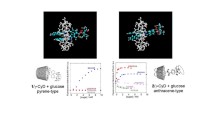Abstract
The chemical sensing of saccharides is of importance for the diagnosis of diabetes. Various enzymatic sensors have been developed, but their heat and pH instability issues need to be resolved. In this regard, the development of artificial saccharide sensors with high stability is attracting attention. We have designed a heat- and pH-stable supramolecular inclusion complex system composed of cyclodextrin (CyD) as a host and a phenylboronic acid (PB) probe possessing pyrene as a fluorescent guest. Several probes possessing alkyl spacers having various lengths between the PB and the pyrene moiety, Cn-APB (n = 1 – 4), were newly synthesized and evaluated with respect to their monosaccharide recognition ability on the basis of the fluorescence response through the cyclic esterification of monosaccharide and PB. These Cn-APB/CyD supramolecular inclusion complexes have exhibited a selective fluorescence response towards fructose in aqueous solution based on the photo-induced electron transfer mechanism. The spacer length of the alkyl group in Cn-APB significantly affects the affinity for saccharides. With respect to the complex between C4-APB and PB-modified CyD (3-PB-γ-CyD), it was found that the supramolecular inclusion complexes had high selectivity for glucose with significant fluorescence enhancement. These results indicate that the lengths of the alkyl spacers in the probe molecules are important to control the recognition of saccharides in aqueous solution.
Similar content being viewed by others
References
T. D. James, K. R. A. S. Sandanayake, and S. Shinkai, Angew. Chem., Int. Ed. Engl., 1996, 35, 1910.
J. P. Lorand and J. O. Edwards, J. Org. Chem., 1959, 24, 769.
Z. Bian, A. Liu, Y. Li, G. Fang, Q. Yao, G. Zhang, and Z. Wu, Analyst, 2020, 145, 719.
T. Kubo, K. Kanemori, R. Kusumoto, T. Kawai, K. Sueyoshi, T. Naito, and K. Otsuka, Anal. Chem., 2015, 87, 5068.
K. Sato, M. Takahashi, M. Ito, E. Abe, and J. Anzai, J. Mater. Chem. B, 2015, 3, 7796.
K. Sugita, Y. Tsuchido, C. Kasahara, M. A. Casulli, S. Fujiwara, T. Hashimoto, and T. Hayashita, Front. Chem., 2019, 7, 806.
Y. Tsuchido, R. Sato, N. Nodomi, T. Hashimoto, K. Akiyoshi, and T. Hayashita, Langmuir, 2016, 32, 10761.
Y. Tsuchido, S. Fujiwara, T. Hashimoto, and T. Hayashita, Chem. Pharm. Bull., 2017, 65, 318.
Y. Suzuki, A. Ikeda, K. Ohno, T. Fujihara, T. Sugaya, and K. Ishihara, J. Org. Chem., 2020, 85, 9680.
M. Mammen, S. K. Choi, and G. M. Whitesides, Angew. Chem. Int. Ed., 1998, 37, 2754.
G. M. Pavan, A. Danani, S. Pricl, and D. K. Smith, J. Am. Chem. Soc., 2009, 131, 9686.
H. Wang, Z. Bie, C. Lü, and Z. Liu, Chem. Sci., 2013, 4, 4298.
X. Wu, Z. Li, X. X. Chen, J. S. Fossey, T. D. James, and Y. B. Jiang, Chem. Soc. Rev., 2013, 42, 8032.
X. Wu, X.-X. Chen, and Y.-B. Jiang, Analyst, 2017, 142, 1403.
X. Sun and T. D. James, Chem. Rev., 2015, 115, 8001.
A.-J. Tong, A. Yamauchi, T. Hayashita, Z.-Y. Zhang, B. D. Smith, and N. Teramae, Anal. Chem., 2001, 73, 1530.
H. Kano, D. Tanoue, H. Shimaoka, K. Katano, T. Hashimoto, H. Kunugita, S. Nanbu, T. Hayashita, and K. Ema, Anal. Sci., 2014, 30, 643.
C. Shimpuku, R. Ozawa, A. Sasaki, F. Sato, T. Hashimoto, A. Yamauchi, I. Suzuki, and T. Hayashita, Chem. Commun., 2009, 1709.
T. Hashimoto, M. Kumai, M. Maeda, K. Miyoshi, Y. Tsuchido, S. Fujiwara, and T. Hayashita, Front. Chem. Sci. Eng., 2020, 14, 53.
M. Kumai, S. Kozuka, M. Samizo, T. Hashimoto, I. Suzuki, and T. Hayashita, Anal. Sci., 2012, 28, 121.
R. Ozawa, T. Hashimoto, A. Yamauchi, I. Suzuki, B. D. Smith, and T. Hayashita, Anal. Sci., 2008, 24, 207.
Author information
Authors and Affiliations
Corresponding authors
Electronic supplementary material
Rights and permissions
About this article
Cite this article
Tsuchido, Y., Kojima, S., Sugita, K. et al. Effect of Spacer Length in Pyrene-Modified-Phenylboronic Acid Probe/CyD Complexes on Fluorescence-based Recognition of Monosaccharides in Aqueous Solution. ANAL. SCI. 37, 721–726 (2021). https://doi.org/10.2116/analsci.20SCP08
Received:
Accepted:
Published:
Issue Date:
DOI: https://doi.org/10.2116/analsci.20SCP08




